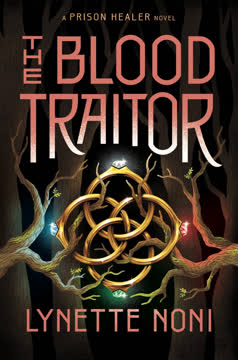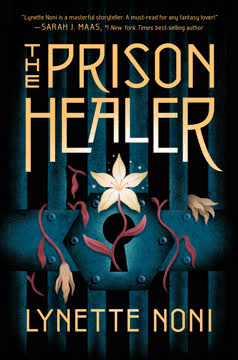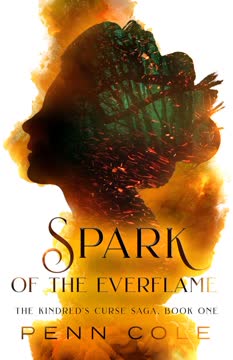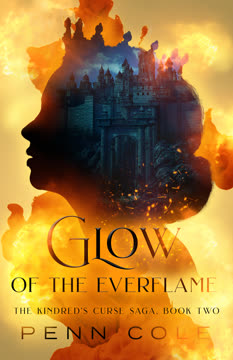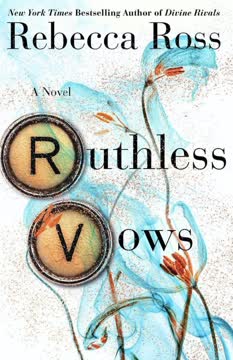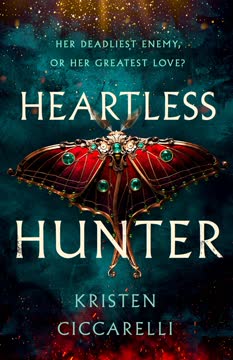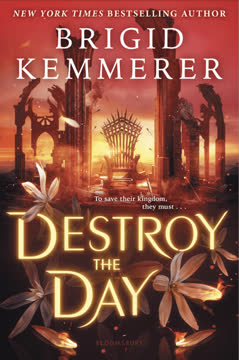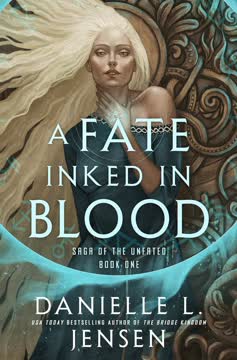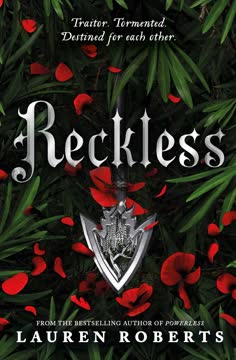Plot Summary
Shadows of Betrayal
After the events of The Gilded Cage, Kiva Corentine is reeling from her role in the fall of Evalon. Her sister Zuleeka has seized the throne with Mirryn, and Kiva's actions have left her estranged from those she loves, especially Jaren, the prince she betrayed. Haunted by guilt and loss, Kiva is forcibly returned to Zalindov prison, drugged and broken, where she must face the consequences of her choices and the darkness within herself.
Return to Zalindov
Kiva's arrival at Zalindov is a descent into hell. Addicted to angeldust, she is barely functional, but Cresta, a former enemy, helps her survive withdrawal. The prison is more brutal than ever, and Kiva is forced into the deadly tunnels, stripped of her healer's role. As she claws her way back to life, she is tormented by memories of those she's lost and the knowledge that her actions have set a kingdom ablaze.
Withdrawal and Survival
Kiva's withdrawal is agonizing, both physically and emotionally. Cresta, repaying a blood debt, becomes her reluctant savior, and through shared suffering, the two form a fragile alliance. Kiva's days blur into labor and pain, but as she slowly recovers, she begins to see a glimmer of hope. The experience hardens her, teaching her the value of survival and the cost of forgiveness.
The Weight of Guilt
As Kiva regains clarity, she is consumed by guilt over her role in the rebellion and the suffering of her friends—Jaren, Naari, Caldon, Tipp, and her brother Torell. She is isolated, believing herself unforgivable, and the darkness of the Abyss threatens to swallow her. Yet, through conversations with Cresta, she begins to confront her past, her family's legacy, and the possibility of redemption.
The King's Bargain
Kiva is unexpectedly released from Zalindov by Mirraven soldiers and taken north to Blackmount Castle. She believes she is to witness her sister's wedding to King Navok, but the truth is more sinister: Navok intends to marry Kiva herself, seeking to use her magic for his own ambitions. Isolated and powerless, Kiva must navigate the treacherous politics of Mirraven, where every kindness hides a threat.
Wedding of Deceit
Navok's plan is to use Kiva's healing magic, combined with the legendary Hand of the Gods, to grant himself elemental power and conquer all of Wenderall. Kiva is imprisoned, tortured, and forced to display her magic. She discovers allies in unlikely places—Ashlyn, disguised as a maid, and Galdric, her mother's old friend, held captive. Together, they plot a desperate escape before the wedding can bind Kiva to Navok forever.
Anomalies and Alliances
Ashlyn reveals herself as the general of Evalon's armies and an anomaly with wind and earth magic. With her help, Kiva, Galdric, and Ashlyn escape Blackmount, using windfunneling magic to return to Evalon. Along the way, Kiva learns of Navok's growing army of anomalies—elemental magic users coerced into his service. The threat to Evalon and all kingdoms is greater than ever.
Escape from Blackmount
The escape is harrowing, but Kiva and her companions reach Stoneforge, a military outpost, where they reunite with Jaren, Caldon, Torell, and others. The reunion is fraught with pain and unresolved anger, especially from Jaren, who cannot forgive Kiva. Yet, as the group shares their stories and the scale of Navok's threat becomes clear, they realize they must work together to save Evalon.
Reunions and Regrets
Kiva's return to her friends is bittersweet. Tipp, Naari, and Caldon struggle with her betrayal, and Jaren is cold and distant. Through honest conversations and shared danger, old wounds begin to heal. Kiva's journey becomes one of self-forgiveness, as she learns that redemption is possible, but only if she fights for it.
The Quest for Rings
To stop Navok, the group must find the four elemental rings—the Hand of the Gods—hidden across Wenderall. Each ring is protected by ancient laws and deadly challenges: a blood-soaked arena in Jiirva, a Mystican's mind games in Hadris, a perilous mountain in Valorn, and a final confrontation in Evalon. Along the way, Kiva's magic is tested, and she must learn to wield it with love, not fear.
Arena of Blood
In Jiirva, Kiva and her friends are forced into the Arzavaar, a gladiatorial trial to the death. Kiva, a healer, must kill to survive, and the trauma of taking a life haunts her. Naari, Cresta, and Ashlyn fight by her side, and together they earn the ring—but at a terrible emotional cost. The experience cements their bond and steels their resolve for what lies ahead.
The Mystican's Price
In Hadris, the ring is held by a Mystican who demands a personal price: Kiva must either kiss Jaren, reopening old wounds, or take angeldust, risking her hard-won sobriety. Kiva chooses the drug, sacrificing her own well-being to spare Jaren further pain. The ordeal brings her darkest secrets into the open, but also paves the way for honesty and healing.
The Hand of the Gods
The last ring is revealed to be the Royal Signet, already in Evalon. As Navok's army of anomalies invades, Galdric's true allegiance is exposed—he has been working with Navok all along, seeking power for himself. In a desperate gambit, Kiva and Ariana outwit Galdric, using a decoy Hand to destroy him. The true Hand, hidden in Kiva's amulet, is used to restore Jaren's magic.
Navok's Invasion
Navok's forces besiege Vallenia, wielding elemental magic and overwhelming numbers. The city is in chaos, and the palace burns. Kiva, Jaren, and their friends fight desperately to protect the kingdom. Cresta, revealed as Navok's long-lost sister, challenges him to a blood duel for the throne of Mirraven, while Zuleeka, corrupted by death magic, prepares for a final confrontation.
The Final Confrontation
Kiva faces Zuleeka on the bridge, their magic clashing in a battle of light and shadow. Drawing on her love for her friends, Kiva heals the darkness in her sister, but Zuleeka's hatred remains. In a final act of vengeance, Zuleeka throws the Eye of the Gods at Jaren, but Kiva intercepts it, losing her magic forever. Zuleeka is defeated, her power broken, and Cresta kills Navok, becoming queen of Mirraven.
Sacrifice and Salvation
Kiva's sacrifice leaves her near death, but she is saved by her friends and the healers of Silverthorn. Caldon, thought dead, is revealed to be alive, saved by Tipp and a Mystican's cure. The group mourns their losses and celebrates their survival. Zuleeka is sentenced to Zalindov, and Rooke, the cruel warden, is finally brought to justice.
Healing and Farewell
With Evalon restored, Jaren's magic returned, and the threat of Navok ended, Kiva and her friends look to the future. Cresta becomes queen of Mirraven, Ashlyn and Torell find new purpose, and Kiva chooses to stay in Vallenia to study healing. The scars of the past remain, but the promise of hope and dreams endures. Together, they have survived—and now, they live.
Characters
Kiva Corentine
Kiva is the heart of the story—a survivor of Zalindov prison, a healer with rare magic, and a young woman burdened by guilt for her role in the fall of Evalon. Her journey is one of self-forgiveness, as she battles addiction, betrayal, and the darkness of her family's legacy. Kiva's relationships—with Jaren, her friends, and her siblings—are fraught with pain and longing, but her capacity for love and sacrifice ultimately saves not only herself, but her world. Her arc is one of transformation: from victim to survivor, from outcast to hero, and from self-loathing to hope.
Jaren Vallentis
Jaren is the crown prince of Evalon, stripped of his magic and throne by Kiva's betrayal and his cousin's treachery. He is defined by his compassion, loyalty, and deep sense of responsibility. Jaren's love for Kiva is both his strength and his vulnerability, and his journey is one of learning to forgive—not just her, but himself. His restoration, both magical and emotional, is central to the story's resolution, and his leadership inspires those around him to fight for a better future.
Zuleeka Corentine
Zuleeka is Kiva's older sister, consumed by ambition and the dark magic of their bloodline. Her actions—seizing the throne, wielding death magic, and betraying her family—are driven by a twisted sense of love and legacy. Zuleeka's psychological complexity lies in her need for power and validation, her jealousy, and her inability to accept forgiveness. Her downfall is both a warning and a tragedy, as she becomes a victim of the very darkness she sought to control.
Caldon Vallentis
Caldon is Jaren's cousin and Kiva's closest confidant, known for his humor, flirtatiousness, and unwavering loyalty. Beneath his bravado lies deep grief and a longing for connection, especially with his estranged sister Ashlyn. Caldon's near-death and resurrection underscore the story's themes of hope and the power of friendship. His evolving relationship with Cresta adds depth to his character, revealing vulnerability and growth.
Cresta Kildarion (Voss)
Cresta begins as Kiva's enemy in Zalindov, but through shared suffering, becomes a steadfast ally. Her journey from prisoner to queen of Mirraven is marked by resilience, cunning, and a refusal to be defined by her past. Cresta's secret identity as Navok's sister and her ultimate challenge for the throne reveal her as a complex figure—capable of both violence and deep loyalty. Her psychological armor hides wounds that only true friendship can heal.
Tipp Peridon
Tipp is Kiva's young friend and former assistant, whose unwavering optimism and loyalty provide emotional ballast for the group. His trauma—witnessing violence, losing his found family, and saving Caldon—forces him to grow up quickly, but he remains a beacon of innocence and forgiveness. Tipp's journey is one of resilience, and his ability to forgive Kiva is a turning point in her own healing.
Ashlyn Vallentis
Ashlyn is Caldon's sister and the general of Evalon's armies, a powerful anomaly with wind and earth magic. Her pragmatic leadership and willingness to risk everything for her kingdom make her a formidable ally. Ashlyn's estrangement from Caldon and her budding relationship with Torell add layers to her character, as she learns to balance duty with personal connection.
Torell Corentine
Torell is Kiva's older brother, the former general of the rebels, torn between family and conscience. His arc is one of atonement, as he seeks to undo the damage caused by Zuleeka and the rebellion. Torell's relationship with Kiva is marked by shared trauma and mutual support, and his growing bond with Ashlyn offers him a chance at healing and belonging.
Naari
Naari is a former Royal Guard, marked by loss and betrayal. Her loyalty to Kiva and Jaren is unwavering, and her skills in battle are matched by her emotional strength. Naari's journey is one of reclaiming agency and finding purpose beyond duty, as she learns to trust and love again.
Galdric Shaw
Galdric is Tilda's old friend and the former leader of the rebels, whose apparent wisdom masks deep ambition and duplicity. His alliance with Navok and ultimate betrayal of Kiva and her friends is a devastating blow, revealing the dangers of unchecked ambition and the corrosive power of secrets. Galdric's fate is a cautionary tale about the cost of power and the importance of trust.
Plot Devices
Duality of Light and Shadow
The story's central device is the duality of healing and death magic, mirroring the psychological struggle between hope and despair, love and hate, forgiveness and vengeance. Kiva's journey to embrace her magic—fueled by love, not fear—parallels her path to self-acceptance. Zuleeka's descent into darkness is a warning of what happens when pain is left unchecked. The Hand of the Gods, capable of both creation and destruction, is the ultimate symbol of this duality.
The Quest Structure
The narrative is structured as a quest for the four elemental rings, each protected by unique challenges that test the characters physically, emotionally, and morally. This device allows for character development, the forging of alliances, and the exploration of different cultures and kingdoms. The quest also serves as a metaphor for the journey toward healing and redemption.
Betrayal and Forgiveness
Betrayal is a recurring motif—Kiva's betrayal of Jaren, Zuleeka's betrayal of her family, Galdric's betrayal of everyone. The story uses foreshadowing and parallel arcs to explore the psychological cost of betrayal and the difficult, often nonlinear path to forgiveness. The narrative structure allows for moments of catharsis, as characters confront their pasts and choose to move forward.
Found Family and Chosen Bonds
The plot repeatedly emphasizes the importance of found family—those who choose to stand by each other despite pain and loss. The relationships between Kiva, Jaren, Caldon, Cresta, Tipp, and the others are tested by trauma but ultimately endure, providing the strength needed to face overwhelming odds. This device is used to contrast with the destructive power of blood ties gone wrong.
Sacrifice and the Limits of Power
The story is unflinching in its portrayal of sacrifice—Kiva's loss of her magic, Caldon's near-death, the deaths and suffering of innocents. The narrative structure uses these moments to question the true meaning of power and the price of peace. The final confrontation is foreshadowed by earlier sacrifices, culminating in Kiva's ultimate act of selflessness.
Analysis
The Blood Traitor is a powerful exploration of the psychological aftermath of betrayal, addiction, and loss. Through Kiva's journey, Lynette Noni examines the ways in which pain can both destroy and transform, and how forgiveness—of oneself and others—is the only path to true healing. The novel's quest structure and magical metaphors allow for a nuanced discussion of agency, the dangers of unchecked ambition, and the necessity of found family. Ultimately, the book argues that survival is not enough; to truly live, one must choose hope, embrace vulnerability, and dare to dream again. The story's resolution, with Kiva's magic gone but her heart whole, is a testament to the idea that our greatest power lies not in what we can do, but in who we choose to become.
Last updated:
FAQ
Synopsis & Basic Details
What is The Blood Traitor about?
- Journey of Redemption: The Blood Traitor follows Kiva Corentine after her role in the rebellion's success leads to the downfall of Evalon's royal family and her return to Zalindov prison, where she must confront her past, addiction, and the consequences of her choices.
- Quest for Power: Forced into an alliance with her former enemies and unexpected allies, Kiva embarks on a perilous quest across kingdoms to gather ancient magical artifacts, the Hand of the Gods, to counter a growing threat from the ambitious Mirraven King Navok and his army of anomalies.
- Battle for Evalon: The journey culminates in a confrontation at the River Palace, where Kiva must face her sister Zuleeka, Navok, and the emotional fallout of her betrayals, ultimately making a sacrifice that determines the fate of her friends, family, and the kingdom.
Why should I read The Blood Traitor?
- Deep Emotional Resonance: The book delves into complex themes of guilt, forgiveness, addiction, and the psychological toll of trauma, offering a raw and honest portrayal of Kiva's struggle for redemption that resonates deeply.
- Intricate World-Building & Magic System: It expands the established world of Wenderall, introducing new kingdoms, cultures, and a deeper understanding of elemental and Corentine magic, including the powerful Hand of the Gods and the dangerous rise of anomalies.
- Satisfying Character Arcs & Relationships: Readers witness significant growth and evolution in beloved characters like Kiva, Jaren, and Caldon, while exploring complex new dynamics and surprising revelations, particularly regarding Cresta and Galdric, leading to powerful moments of reconciliation and sacrifice.
What is the background of The Blood Traitor?
- Immediate Aftermath: The story picks up directly after the dramatic ending of The Gilded Cage, dealing with the immediate consequences of Zuleeka Corentine and Mirryn Vallentis seizing the Evalonian throne and Kiva's forced return to Zalindov.
- Ancient Feud & Prophecy: It is rooted in the ancient conflict between the Corentine and Vallentis bloodlines, exploring the legacy of Torvin and Sarana and the prophecy surrounding their magic, which becomes central to the quest for the Hand of the Gods.
- Political Instability: The narrative is set against a backdrop of widespread political turmoil in Wenderall, with the Evalonian throne overthrown, alliances shifting (Evalon/Mirraven, Mirraven/Caramor), and King Navok of Mirraven actively seeking to expand his power across the continent.
What are the most memorable quotes in The Blood Traitor?
- "You are who you choose to be. You are what you choose to be.": Spoken by Cresta to a drug-addled Kiva in Zalindov (Chapter 1), this quote becomes a central theme for Kiva's journey, emphasizing agency and self-determination in the face of overwhelming circumstances and past mistakes.
- "He hates that he fell in love with you. He hates everything that happened—and he blames himself more than anyone. Including you.": Caldon reveals Jaren's inner turmoil to Kiva (Chapter 10), highlighting the depth of Jaren's pain and self-recrimination after Kiva's betrayal, and underscoring the complexity of their fractured relationship.
- "I chose you, Jaren. I will always choose you. Because I love you, and I—": Kiva's raw declaration to Jaren on Mount Nebu (Chapter 26) marks a pivotal emotional turning point, signifying her acceptance of her feelings, her choice of him over her family's legacy, and paving the way for their reconciliation.
What writing style, narrative choices, and literary techniques does Lynette Noni use?
- First-Person Perspective: The story is told primarily from Kiva's first-person point of view, immersing the reader in her internal struggles, emotional turmoil, and subjective experience of the events, particularly effective during her withdrawal and moments of intense guilt.
- Visceral and Sensory Language: Noni employs vivid descriptions, especially in depicting the harsh realities of Zalindov, the sensory overload of the Midnight Markets, and the physical sensations of magic and pain, drawing the reader deeply into Kiva's physical and psychological state.
- Foreshadowing and Symbolism: Subtle hints and recurring motifs (like the duality of light and shadow magic, the significance of touch, and the symbolism of the rings/amulet) are woven throughout the narrative, building suspense and adding layers of meaning to the characters' journeys and the overarching plot.
Hidden Details & Subtle Connections
What are some minor details that add significant meaning?
- Galdric's Prologue Appearance: The opening scene featuring Tilda and Galdric crying in a tent (Prologue) initially seems to portray Galdric as Tilda's loyal confidant, begging for his queen's help. This seemingly minor detail gains immense significance later when it's revealed he was manipulating Tilda and planning his own rise to power, highlighting his deep-seated duplicity from the very beginning.
- Cresta's Serpent Tattoo: Cresta's prominent serpent tattoo (Chapter 1) is more than just a physical identifier; it subtly foreshadows her hidden identity as Crestoria Vossendi Kildarion, sister to King Navok. The serpent, often associated with cunning and transformation, mirrors her journey from a hardened prisoner to a strategic player and eventual queen.
- The Mystican's Riddle: Zofia Sage's riddle, "Enter in if you dare, but do so being fully aware, there is a payment to prepare: the heart will tell what you most care" (Chapter 22), is a seemingly simple warning. However, it precisely predicts the nature of the price she demands (facing a deep fear) and the emotional core of Kiva's choice, emphasizing the Mystican's uncanny ability to perceive inner truths.
What are some subtle foreshadowing and callbacks?
- Kiva's Magic and Water: Kiva's near-drowning experiences (Trial by Water, Queen Ariana's attack) are callbacks that subtly foreshadow the air anomaly's attempt to drown her in the Jiirvan arena (Chapter 26). This recurring motif highlights Kiva's vulnerability to water and emphasizes the life-or-death stakes of magical combat, even against elements seemingly unrelated to her healing power.
- Caldon's Avoidance of Military Bases: Caldon's discomfort and avoidance of military outposts like Stoneforge (Chapter 10) are subtle hints at his unresolved trauma related to his parents' death in a shipwreck. His eventual willingness to stay at Stoneforge and later Highworth Keep signifies his emotional growth and reconciliation with his past and his sister, Ashlyn.
- The Royal Signet's Appearance: The brief mention and visual description of Queen Ariana wearing the Royal Signet ring (Chapter 28) is a crucial piece of subtle foreshadowing. It appears as a seemingly normal royal artifact, but its later revelation as the final piece of the Hand of the Gods, hidden in plain sight, is a powerful callback to Sarana's original plan and adds a layer of clever misdirection to the quest.
What are some unexpected character connections?
- Cresta and Navok's Sibling Relationship: The most unexpected connection is the reveal that Cresta Voss is actually Crestoria Kildarion, King Navok's long-lost sister (Chapter 30). This transforms Cresta from a mere ally into a key player in the political landscape and provides a deeply personal motivation for her actions against Navok, rooted in their shared traumatic past and his betrayal of their sister, Serafine.
- Galdric's Alliance with Navok: Galdric Shaw, initially presented as Tilda's loyal friend and rebel leader, is revealed to have been working with King Navok all along (Chapter 29). This connection is shocking because it recontextualizes all of Galdric's actions, from lying to Tilda about Kiva's release to manipulating Kiva into collecting the rings, exposing his ambition and duplicity.
- Naari's Jiirvan Past: Naari's history as a former arena warrior in Jiirva (Chapter 15) is an unexpected connection to one of the quest locations. This personal history adds depth to her character, explaining her stoicism and combat skills, and provides unique insight into the brutal culture and the stakes of the Arzavaar trial.
Who are the most significant supporting characters?
- Cresta Kildarion (Voss): Beyond her initial role as Kiva's reluctant savior, Cresta becomes a vital ally, offering pragmatic survival skills, emotional support, and unexpected humor. Her hidden identity and challenge to Navok make her pivotal to the climax and the resolution of the Mirraven conflict, establishing her as a powerful figure in her own right.
- Ashlyn Vallentis: As the General of Evalon's armies and a powerful anomaly, Ashlyn provides crucial strategic leadership, magical support, and a vital connection to the Vallentis family's resources. Her personal journey of reconciliation with Caldon and her budding relationship with Torell add significant emotional depth to the narrative.
- Galdric Shaw: Although ultimately revealed as a villain, Galdric is a significant supporting character due to his deep knowledge of Corentine history, magic, and the Hand of the Gods. His manipulation drives a large portion of the plot, and his betrayal serves as a major turning point, highlighting the theme of trust and its fragility.
Psychological, Emotional, & Relational Analysis
What are some unspoken motivations of the characters?
- Kiva's Need for Punishment: Beyond her stated guilt, Kiva's initial passive acceptance of her suffering in Zalindov (Chapter 2) suggests an unspoken motivation: a deep-seated belief that she deserves the pain as penance for her perceived failures and betrayals. Her numbness is a psychological defense mechanism against this overwhelming self-recrimination.
- Jaren's Protective Instinct: Despite his anger and stated desire to distance himself from Kiva, Jaren's actions repeatedly reveal an unspoken, deeply ingrained protective instinct towards her (e.g., his panicked reaction to Caldon's fire training, his immediate move to shield her on the bridge). This suggests his love and concern for her are involuntary, overriding his conscious attempts to remain detached.
- Cresta's Search for Belonging: While Cresta claims to act out of blood debt or self-interest, her increasing integration into the group and her eventual challenge to Navok (Chapter 30) are driven by an unspoken motivation: a longing for belonging and a desire to protect the "found family" she has unexpectedly gained after years of isolation and loss. Her initial churlishness is a defense against vulnerability.
What psychological complexities do the characters exhibit?
- Kiva's Trauma and Addiction: Kiva's psychological complexity is most evident in her struggle with angeldust addiction and withdrawal (Chapters 1-3). The narrative portrays the physical and mental agony, the shame, and the lingering fear of relapse (Chapter 23), showcasing the deep psychological scars left by her time in Zalindov and the trauma of being drugged.
- Jaren's Grief and Identity Crisis: Jaren exhibits psychological complexity as he grapples with the loss of his magic and his identity as the elemental prince (Chapter 10, 27). His struggle is compounded by grief over his father's death and the betrayal by Kiva and Mirryn, leading to moments of lashing out and self-blame before he begins to heal and redefine himself beyond his powers.
- Zuleeka's Corruption and Jealousy: Zuleeka's descent into madness and cruelty (Chapter 31) is portrayed as a complex interplay of inherited dark magic and deep-seated psychological issues, particularly jealousy towards Kiva and a desperate need for validation and power. Her inability to feel remorse or accept healing highlights the destructive nature of unchecked ambition and emotional darkness.
What are the major emotional turning points?
- Kiva's Acceptance of Self: A major emotional turning point occurs when Kiva, alone in the infirmary, chooses to embrace her magic and her identity as a healer, fueled by love and hope rather than fear (Chapter 14). This internal shift allows her to overcome her magical block and begin her path toward self-forgiveness and active participation in the quest.
- Jaren and Kiva's Reconciliation: The emotional climax of their relationship occurs on Mount Nebu (Chapter 26) when Jaren confesses he never hated Kiva and she declares her unwavering love for him. This raw, honest conversation, prompted by a near-death experience, allows them to break through weeks of pain and miscommunication, leading to a powerful reconciliation.
- Caldon and Ashlyn's Reunion: The emotional turning point for the Vallentis siblings happens after the Jiirvan arena battle (Chapter 16), when Caldon, fearing he could have lost Ashlyn, finally confronts his guilt over avoiding her. Their tearful embrace and apology signify the healing of a long-standing rift and the reaffirmation of their deep sibling bond.
How do relationship dynamics evolve?
- Kiva and Cresta: Their dynamic evolves from mutual animosity and reluctant alliance in Zalindov (Chapters 1-4) to a complex, fiercely loyal friendship (Chapters 16, 24). Cresta's blunt honesty and unwavering support help Kiva survive, while Kiva's acceptance and inclusion offer Cresta a sense of belonging, culminating in Cresta's protective fury when Kiva is harmed.
- Kiva and Jaren: Their relationship transforms from deep love and trust to devastating betrayal and painful estrangement (Chapters 1-10). The quest forces them into proximity, leading to moments of lingering affection mixed with resentment, culminating in a raw confrontation and passionate reconciliation (Chapter 26) that rebuilds their bond on a foundation of honesty and forgiveness.
- Torell and Ashlyn: Their dynamic shifts from wary respect between opposing generals (Chapter 11) to a burgeoning romantic connection (Chapters 18-19). Their shared experiences, mutual admiration for each other's leadership, and willingness to bridge the divide between their families allow a genuine relationship to develop, symbolizing hope for unity between Corentines and Vallentis.
Interpretation & Debate
Which parts of the story remain ambiguous or open-ended?
- The Future of Corentine Magic: While Kiva loses her healing magic and Zuleeka's death magic is purged, the long-term implications for the Corentine bloodline's magical abilities remain somewhat open-ended. It's unclear if the potential for either healing or death magic is permanently gone from the line or merely dormant, leaving room for future stories or interpretations.
- The Fate of Navok's Anomalies' Families: The story reveals that Navok coerced his anomaly army by kidnapping their loved ones and holding them at Darkwell Keep (Chapter 27). While Navok is defeated, the fate of these imprisoned families is not explicitly detailed, leaving their release and reunion with the surviving anomalies as an unresolved element.
- The Full Extent of Mystican Magic: Zofia Sage's abilities (mind-reading, fortune-telling, creating a cure for necros venom) are portrayed as powerful and mysterious (Chapters 22-23, 32). The narrative hints at the broader capabilities of Mysticans from Adastria and Mahari but doesn't fully explain their magic system, leaving much about their powers and origins ambiguous.
What are some debatable, controversial scenes or moments in The Blood Traitor?
- Cresta Stabbing Jaren: Cresta deliberately stabbing Jaren in the thigh to provoke Kiva's magic (Chapter 14) is a highly debatable moment. While framed as necessary motivation for Kiva's training, the act is violent, causes Jaren real pain, and uses his vulnerability against him, raising questions about the morality of the characters' methods and whether the ends justify the means.
- Kiva Choosing Angeldust over Kissing Jaren: Kiva's decision to take angeldust rather than kiss Jaren to pay the Mystican's price (Chapter 23) is controversial. It highlights the depth of her trauma and fear of emotional vulnerability, but also involves a self-destructive choice that risks her sobriety and causes her significant harm, prompting debate about whether it was a necessary sacrifice or a misguided act of self-punishment.
- Rooke's Punishment: The decision to sentence Warden Rooke to the Trial by Ordeal at Zalindov (Chapter 33), a trial he himself oversaw and which is essentially a death sentence, is a moment open to debate. While framed as justice for his atrocities, it mirrors his own cruelty and raises questions about whether the heroes are perpetuating the cycle of violence they sought to end.
The Blood Traitor Ending Explained: How It Ends & What It Means
- Climax and Sacrifice: The story culminates in a chaotic battle at the River Palace. Kiva confronts Zuleeka on the bridge, using her love-fueled healing magic to purge her sister's death magic. However, Zuleeka, defeated but unrepentant, throws the Eye of the Gods at Jaren. Kiva intercepts the dagger, losing her magic but saving Jaren's powers and his right to rule. Cresta simultaneously defeats and kills her brother, Navok, in a blood duel, becoming queen of Mirraven.
- Resolution and New Beginnings: Kiva is gravely wounded but survives, healing at Silverthorn. Caldon, thought dead from Galdric's betrayal, is revealed to be alive, saved by Tipp and a Mystican cure. Galdric is destroyed by the Hand of the Gods. Zuleeka is sentenced to Zalindov, and Warden Rooke is also brought to justice via the Trial by Ordeal. Jaren's magic is restored, and the Vallentis family reclaims the throne.
- Meaning and Themes: The ending signifies the triumph of love, forgiveness, and found family over betrayal, ambition, and darkness. Kiva's sacrifice highlights that true power lies not just in magic, but in selfless love and the choices one makes. Her loss of magic, while painful, frees her from the fear of her bloodline's darkness and allows her to pursue her dream of becoming a healer through conventional means. The final scene at Zalindov, with Rooke facing the Trial and the promise of prison reform, symbolizes a breaking of the cycle of cruelty and a future built on justice and hope. The story concludes with Kiva choosing to stay in Vallenia with Jaren and her friends, embracing a future defined by healing and dreams.
Review Summary
The Blood Traitor receives mostly positive reviews, with readers praising its emotional depth, character development, and satisfying conclusion to the trilogy. Many highlight the found family aspect and the growth of protagonist Kiva. Some criticize pacing issues and predictable plot twists. The romance between Kiva and Jaren divides opinions, with some finding it frustrating while others enjoy their dynamic. Overall, fans appreciate the series' world-building, magic system, and themes of hope and redemption.
The Prison Healer Series
Similar Books
Download PDF
Download EPUB
.epub digital book format is ideal for reading ebooks on phones, tablets, and e-readers.
